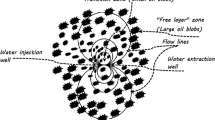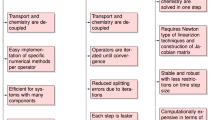Abstract
The subsurface spill of hydrocarbon fluids (from an underground leaking tank or from pipelines) is a widespread problem in the oil industry and hydrology. Under the assumption of low oil saturation, the migration of oil pollutant may be modeled by a nonlinear convection–diffusion equation with power law nonlinearities. The saturation-dependent diffusion coefficient is proportional to a power of saturation for which the exponent may be negative or positive depending on the porous medium and the pollutant characteristics. This paper presents general analytical solutions for the one-dimensional transient saturation distribution in immiscible zone. The solutions describe the longtime behavior of a contaminant oil pollutant caused by a continuous source of contaminant (e.g., leakage from pipelines, disposal dumps or storage tanks). Two general forms corresponding to positive and negative power exponents of the diffusion coefficient are presented. The general forms express implicitly the position as function of oil saturation and time. An alternative explicit closed-form solution near the front position is also proposed. An exact explicit solution is obtained for the particular case of constant diffusion coefficient. The proposed solutions are fully analytical in the sense that they do not require any numerical implementation. The solutions may be used to study the porous medium and pollutant parameters. They can be applied to aquifer contamination problems, and they are also important for the verification of numerical solutions.

(Source: https://www.epa.gov/education/magnificent-ground-water-connection; Getting Up to Speed: Ground Water Contamination)








Similar content being viewed by others
References
Abramowitz, M., Stegun, I.A.: Handbook of Mathematical Functions with Formulas, Graphs and Mathematical Tables, pp. 1046. Dover publications, Inc., New York (1972)
Ataie-Ashtiani, B., Raeesi-Ardekani, D.: Comparison of numerical formulations for two-phase flow in porous media. Geotech. Geol. Eng. 28(4), 373–389 (2010)
Bear, J.: Dynamics of Fluids in Porous Media. Dover, New York (1988)
Chen, Z.-X.: Some invariant solutions to two-phase fluid displacement problem including capillary effect. Soc. Pet. Eng. J. 3, 691–700 (1988)
Garg, S., Rixey, W.G.: The dissolution of benzene, toluene, m-xylene and naphthalene from a residually trapped non-aqueous phase liquid under mass transfer limited conditions. J. Contam. Hydrol. 36(3–4), 313–331 (1999)
Gradshteyn, I.S., Ryzhik, I.M.: Table of Integrals, Series, and Products, 7th edn. Academic, San Diego, CA (2007)
Grundy, R.E.: Asymptotic solution of a model non-linear convective diffusion equation. IMA J Appl Math 31(2), 121–137 (1983)
Hindmarsh, A.C., Gresho, P.M., Griffiths, D.F.: The stability of explicit Euler time-integration for certain finite difference approximations of the multi-dimensional advection-diffusion equation. Int. J. Numer. Methods Fluids 4(9), 853–897 (1984)
Hochmuth, D.P., Sunada, D.K.: Ground-water model of two-phase immiscible flow in coarse material. Ground Water 23(5), 617–626 (1985)
Hossain, M.K., Corapeioglu, M.Y.: Modifying the USGS transport computer model to predict high-density hydrocarbon migration. Ground Water 26(6), 717–723 (1988)
Høst-Madsen, J., Høgh Jensen, K.: Laboratory and numerical investigations of immiscible multiphase flow in soil. J. Hydrol. 135(1–4), 13–52 (1992)
Hoteit, H., Firoozabadi, A.: An efficient numerical model for incompressible two-phase flow in fractured media. Adv. Water Resour. 31(6), 891–905 (2008)
King, L.G.: Imbibition of fluids by porous solids. Thesis dissertation, Colorado State University, Fort Collins (1964)
Lagendijk, V., Forkel, C., Köngeter, J., Braxein, A.: Three dimensional numerical modeling of multiphase flow and transport. J. Environ. Sci. Health Part A 36(8), 1473–1489 (2001)
Li, W., Wei, C.: An efficient finite element procedure for analyzing three-phase porous media based on the relaxed Picard method. Int. J. Numer. Methods Eng. 101(11), 825–846 (2015)
Marle, C.M.: Multiphase Flow in Porous Media. Gulf Publishing, Houston (1981)
Morel-Seytoux, H.J.: Two-phase flow in porous media. In: Advances in Hydroscience, vol 9, pp. 120–202. Academic, New York (1973)
Morrow, N.R., Harris, C.C.: Capillary equilibrium in porous materials. Soc. Pet. Eng. J. 5, 15–24 (1965)
Park, C.-H., Böttcher, N., Wang, W., Kolditz, O.: Are upwind techniques in multi-phase flow models necessary? J. Comput. Phys. 230(22), 8304–8312 (2011)
Pfankuck, H.O.: Determination of the contaminant source strength from mass exchange processes at petroleum ground water interface in shallow aquifer systems. In: Proceedings of the Petroleum Hydrocarbons and Organic Chemical in Groundwater-Prevention Detection and Restoration; National Water Well Association Conference, Houston, TX (1984)
Pinder, G.F., Abriola, L.M.: On the simulation of nonaqueous phase organic compounds in the subsurface. Water Resour. Res. 22(9S), 109S–119S (1986)
Pirson, S.J.: Oil Reservoir Engineering. McGraw-Hill, New York (1958)
Pistiner, A.: Oil plume distribution in an anisotropic porous medium. Transp. Porous Med. 70, 293–304 (2007)
Pistiner, A.: Oil plume distribution in an aquifer near an impermeable barrier. Transp. Porous Med. 76, 67–75 (2009)
Pistiner, A., Shapiro, M.: A model of groundwater pollution from an underground source. Water Resour. Res. 32(7), 2311–2314 (1996)
Pistiner, A., Shapiro, M.: Contamination pattern in groundwater resulting from an underground source. J. Eng. Math. 33, 15–30 (1998)
Pistiner, A., Shapiro, M., Rubin, H.: Analysis of fuel pollutant migration in water flow through porous media. Int. J. Multiph. Flow 15, 135–154 (1989)
Pistiner, A., Shapiro, M., Rubin, H.: Similarity solutions for immiscible phase migration in porous media: an analysis of free boundaries. Transp. Porous Med. 5, 491–515 (1990)
Pistiner, A., Shapiro, M., Rubin, H.: Gravitational migration of fuel in porous media. Transp. Porous Med. 9, 187–205 (1992)
Ramakrishnan, T.S., Wasan, D.T.: Effect of capillary number on the relative permeability function for two-phase flow in porous media. Powder Technol. 48, 99–124 (1986)
Ramakrishnan, T.S., Wilkinson, D., Dias, M.: Effect of capillary pressure on the approach to residual saturation. Transp. Porous Med. 3, 51–79 (1988)
Reeves, H.W., Abriola, L.M.: An iterative compositional model for subsurface multiphase flow. J. Contam. Hydrol. 15(4), 249–276 (1994)
Rosenau, P., Kamin, S.: Thermal waves in an absorbing and convecting medium. Physica D 8, 273–283 (1983)
Samimi, S., Pak, A.: A novel three-dimensional element free Galerkin (EFG) code for simulating two-phase fluid flow in porous materials. Eng. Anal. Bound. Elem. 39, 53–63 (2014)
Soo, H., Radke, C.J.: Filtration model for the flow of dilute stable emulsions in porous media. Chem. Eng. Sci. 41, 263–272 (1986)
Spielman, L.A., Su, Y.P.: Coalescence of oil in water suspensions by flow through porous media. Ind. Eng. Chent. Fundam. 16, 272–282 (1977)
Tam, E.K.L., Byer, P.H.: Remediation of contaminated lands: a decision methodology for site owners. J. Environ. Manag. 64(4), 387–400 (2002)
Thavamani, P., Megharaj, M., Naidu, R.: Multivariate analysis of mixed contaminants (PAHs and heavy metals) at manufactured gas plant site soils. Environ. Monit. Assess. 184(6), 3875–3885 (2012)
Wilson, J.L., Conrad, S.H.: Is physical displacement of residual hydrocarbons a realistic possibility in aquifer restoration? In: Proceedings of the Petroleum Hydrocarbons and Organic Chemicals in Groundwater-Prevention Detection and Restoration; National Water Well Association Conference, Houston, TX (1984)
Author information
Authors and Affiliations
Corresponding author
Appendix A: Mass of Penetrating Oil Pollutant into Semi-infinite Aquifer
Appendix A: Mass of Penetrating Oil Pollutant into Semi-infinite Aquifer
The mass of oil pollutant entering a semi-infinite aquifer which is initially free of oil may be defined as
where \(x_{\mathrm{D}_{\mathrm{f}}} \left( {t_\mathrm{D} } \right) =\vartheta t_\mathrm{D} =S_*^{n-1} t_\mathrm{D} \) is the oil pollutant front position at time \(t_\mathrm{D} \) and \(S_0 \left( {t_\mathrm{D} } \right) \) is the oil saturation at the left boundary of the aquifer.
The value \(\hbox {d}x_\mathrm{D} /\hbox {d}S\) appearing in the right-hand side of (A.1) can be calculated from (36) by deriving with respect to S (i.e., note that \({\varPhi }=S\), \(\xi =x_\mathrm{D} -\vartheta t_\mathrm{D} \) and \(\xi _f =0)\). We obtain after some mathematical manipulations
Substituting (A.2) into (A.1) we get after making the change of variable \(u=\left( {S/S_*} \right) ^{n-1}/\left( {1-\left( {S/S_*} \right) ^{n-1}} \right) \)
where \(\zeta =\left( {S_0 /S_*} \right) ^{n-1}/\left( {1-\left( {S_0 /S_*} \right) ^{n-1}} \right) \).
The integral in (A.3) can be evaluated analytically by using equation (1) of 3.194, p. 315 of Gradshteyn and Ryzhik (2007) and the Pfaff transformation. We finally obtain
Rights and permissions
About this article
Cite this article
Hayek, M. A Model for Subsurface Oil Pollutant Migration. Transp Porous Med 120, 373–393 (2017). https://doi.org/10.1007/s11242-017-0926-9
Received:
Accepted:
Published:
Issue Date:
DOI: https://doi.org/10.1007/s11242-017-0926-9




